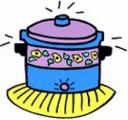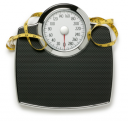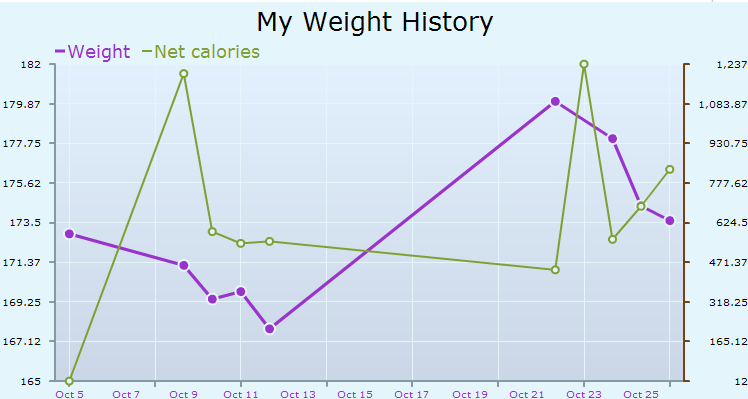 This is part three of an ongoing series. Check out parts one and two.
This is part three of an ongoing series. Check out parts one and two.
Paradoxically, two of the biggest obstacles to the aspiring ex-fattie are too much time and not enough time. Most of us lead busy, but sedentary, lives. We spend 10+ hours a day at a desk, and then go home and work from there, too. We spend our down time surfing the web and channel surfing. Part of the reason we gained weight in the first place is that we filled the extra time with food. We eat salty snacks from a bag at our desk, eat breakfast from the drive-through in our car, and accompany YouTube with fried tubers. We know we should eat better, but cooking lean meats and veggies is certainly more time consuming than picking up an Extra Value Meal, a pizza or a platter of General Tso’s Chicken.
Cutting out the snacks is relatively simple, if not exactly easy. Make sure you eat at least 1-2 healthy snacks during the day. I’m partial to fresh fruit and 100 calorie granola bars. Also, as much as possible, follow the Eat Only At The Table rule, which cuts down on unhealthy chips-and-the-remote time. Finally, remember that deprivation is bad and moderation is good, so a few chips or pretzels go a long way.
 You’ll get most of your calories at meals, however, so what’s a busy netizen to do? Embrace convenience. Your tool comes not from the 21st century, but the 1950s – the slow cooker. It sounds hokey, but one of my best weapons against fatty meals has been the Crock-Pot. Chop up a bunch of stuff in the morning, let it cook all day, and dinner is waiting when you get home. We have a well-loved copy of a Better Homes & Gardens Crockery Cookbook (published in 1994 and now out of print, but available used from Amazon). The White Chicken Chili and Tex-Mex Beef Fajitas are both good and less than 500 calories for a filling amount. There’s also a surprisingly good meatloaf recipe.
You’ll get most of your calories at meals, however, so what’s a busy netizen to do? Embrace convenience. Your tool comes not from the 21st century, but the 1950s – the slow cooker. It sounds hokey, but one of my best weapons against fatty meals has been the Crock-Pot. Chop up a bunch of stuff in the morning, let it cook all day, and dinner is waiting when you get home. We have a well-loved copy of a Better Homes & Gardens Crockery Cookbook (published in 1994 and now out of print, but available used from Amazon). The White Chicken Chili and Tex-Mex Beef Fajitas are both good and less than 500 calories for a filling amount. There’s also a surprisingly good meatloaf recipe.
Precooking chicken breast and chopping onions still too hard? There are some really tasty mixes now available that do most of the work for you. Chop some meat, add the mix and water, and you’re done. Avoid the Banquet kits from the freezer section. They’re horrible. Wouldn’t-feed-it-to-your-dog horrible. These are better:
Canterbury Naturals La Comida Del Dia Chili Mix: Canterbury Naturals, produced by Medina, WA-based Conifer, Inc., makes several quick-cook soup mixes. These can be prepared in 30-45 minutes on the stovetop, but they work really well in a slow cooker as well. This chili mix is no longer produced, but still stocked at Ukrop’s in Richmond, and readily available at Whole Foods. It’s a vegetarian chili made with a base of Spicy V-8 juice. About 170 calories per cup, and really good.
Canterbury Naturals Roasted Garlic Potato Corn Chowder Mix: another soup mix from Canterbury Naturals. This one takes more work, as you have to chop onions and garlic and fry some bacon. I usually either skip the bacon or use pre-cooked bits (not the fake ones, thank you very much). Pre-minced garlic from the produce section works well, too, as it’s just going to simmer all day with the roasted garlic in the mix. make it with half half-and-half and half skim milk, for less than 200 calories per cup. The mix makes 12 cups, so be prepared for leftovers.
Purely American Santa Fe Chipotle Southwest Bean Bake: Purely American, based in Norfolk, VA, makes eight meal kits as part of its Slow Cooker Gourmet line. They’re all available online, but I can find three or four of the flavors at Ukrop’s. The bean bake is a chili-like combination of beans, stew beef and spices. You add the beef, some chopped squash and tomato sauce. The leftovers are especially good rolled in a tortilla with some low-fat cheese and salsa. 310 calories as prepared, plus another 100 for a tortilla.
Purely American Italian Bistro Bean and Pasta Soup Mix: a combination of beans, barley, carrots, onions, potatoes, peas and bell peppers with tri-colore pasta. You add your own chicken breast, chopped zucchini, wine and canned tomatoes. This is pretty good, but not as good as the bean bake. With any of the Purely American kits containing lima beans, be sure to soak overnight per the label instructions, or else the limas won’t cook all the way through. 220 calories as prepared, so you can add some crusty bread and a salad for a nice meal. It pairs well with the Ecce Panis Roasted Garlic loaf most grocers carry.
![]()
 I’m always on the lookout for fast, easy, tasty and healthy meal ideas as a recovering Fat Guy with a full-time job and two kids. Between work, basketball practice, basketball games, homework and PTA meetings, it’s just a little to easy to fall into the burgers and pizza trap, and there’s only so much damage one can counteract with lunchtime at the YMCA. One of our local Krogers has started carrying three varieties of
I’m always on the lookout for fast, easy, tasty and healthy meal ideas as a recovering Fat Guy with a full-time job and two kids. Between work, basketball practice, basketball games, homework and PTA meetings, it’s just a little to easy to fall into the burgers and pizza trap, and there’s only so much damage one can counteract with lunchtime at the YMCA. One of our local Krogers has started carrying three varieties of  For a long time, toasted sandwich vendor Quiznos refused to provide nutritional information for its menu, other than for the subs billed as low-fat, for which they were required by law to provide nutritional data. Thus, you were allowed to know the calorie content of the Honey Bourbon Chicken sandwich (310 for a small), but not the Black Angus Steak (520, as it turns out). This has now changed. In the stores, they still only post nutritional information for
For a long time, toasted sandwich vendor Quiznos refused to provide nutritional information for its menu, other than for the subs billed as low-fat, for which they were required by law to provide nutritional data. Thus, you were allowed to know the calorie content of the Honey Bourbon Chicken sandwich (310 for a small), but not the Black Angus Steak (520, as it turns out). This has now changed. In the stores, they still only post nutritional information for  Part of an occasional series.
Part of an occasional series. 

 This is part three of an ongoing series. Check out parts
This is part three of an ongoing series. Check out parts  You’ll get most of your calories at meals, however, so what’s a busy netizen to do? Embrace convenience. Your tool comes not from the 21st century, but the 1950s – the slow cooker. It sounds hokey, but one of my best weapons against fatty meals has been the Crock-Pot. Chop up a bunch of stuff in the morning, let it cook all day, and dinner is waiting when you get home. We have a well-loved copy of a Better Homes & Gardens Crockery Cookbook (published in 1994 and now out of print, but
You’ll get most of your calories at meals, however, so what’s a busy netizen to do? Embrace convenience. Your tool comes not from the 21st century, but the 1950s – the slow cooker. It sounds hokey, but one of my best weapons against fatty meals has been the Crock-Pot. Chop up a bunch of stuff in the morning, let it cook all day, and dinner is waiting when you get home. We have a well-loved copy of a Better Homes & Gardens Crockery Cookbook (published in 1994 and now out of print, but  Today marks a milestone – I long ago set a goal weight of 170 pounds, which puts me squarely in the
Today marks a milestone – I long ago set a goal weight of 170 pounds, which puts me squarely in the